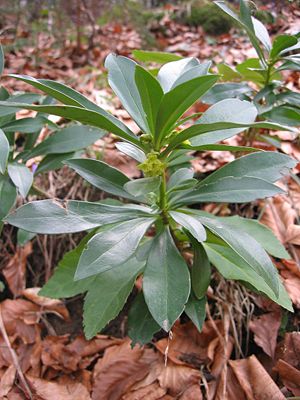Laurel daphne
| Laurel daphne | ||||||||||||
|---|---|---|---|---|---|---|---|---|---|---|---|---|

Laurel daphne ( Daphne laureola ) |
||||||||||||
| Systematics | ||||||||||||
|
||||||||||||
| Scientific name | ||||||||||||
| Daphne laureola | ||||||||||||
| L. |
The Daphne laureola ( Daphne laureola ), also Evergreen Seidelbast or forest laurel called, is a plant from the genus Seidelbast ( Daphne ) within the family of Thymelaeaceae (Thymelaeaceae).
description
Vegetative characteristics
The laurel daphne is an evergreen, woody plant that grows as a small shrub (nanophanerophyte) and usually reaches heights of 50 to 100 (40 to 120) centimeters. It is not very branched. The bark is initially yellow-green and later light gray.
The alternately arranged leaves are divided into short petioles and leaf blades. The bald, leathery leaf blade is 3 to 10 centimeters long and lanceolate to obovate. The upper side of the leaf is matt dark green and the underside is yellowish with a strong central nerve.
Generative characteristics
The flowering period extends from February to May. Three to seven flowers are in a short-stalked, racemose inflorescence in the leaf axils near the branch tip. The grow to The weakly scented, hermaphrodite flowers are four-fold. The four yellowish-green, corolla-like sepals have grown together to form a bare tube. Petals cannot be seen.
The 5 to 10 millimeter long, egg-shaped drupes begin to ripen from July and are blue-black when ripe.
Chromosome number
The number of chromosomes is 2n = 18.
Occurrence and endangerment
The distribution area includes the Mediterranean area , western and southern Europe and North Africa .
The laurel daphne is seldom to often found in Austria in the federal states of Vienna, Lower Austria , Upper Austria , Styria and Carinthia . In Switzerland , the laurel daphne grows in the Jura , in the western plateau , in southern Ticino , in the Valais in the lower Rhone Valley and in the central northern Alps .
In Germany the laurel daphne occurs naturally only in the southern Black Forest and the Middle Rhine and was rated in 1996 in the Red List of Endangered Plant Species as Category 3 = endangered.
This lime-loving plant prefers warm, winter mild deciduous forests (especially beech forests) and bushes with moderately dry loose soil as a location . In the mountainous region , the laurel daphne penetrates to altitudes of 1000 meters. It grows in colline to montane altitudes . In Central Europe it is a character species of the Querco-Fagetea class, occurs particularly in plant communities of the Quercion pubescenti-petraeae association, but also in associations of the Fagion, Tilio-Acerion or Carpinion associations.
The laurel daphne rarely goes wild.
Toxicity
The laurel daphne is highly toxic due to daphnetoxin .
Systematics
The first publication of Daphne laureola was in 1753 by Carl von Linné in Species Plantarum , 1; P. 357.
By Daphne laureola two subspecies have been described:
- Daphne laureola L. subsp. laureola : It reaches heights of 40 to 120 centimeters. The flower tube is 5 to 9 millimeters long.
- Daphne laureola subsp. philippii (Gren.) Rouy : It reaches heights of 20 to 40 centimeters. The branches are more or less prostrate. The flower tube is 3 to 5 millimeters long. This subspecies occurs in the Pyrenees.
Daphne laureola forms the hybrid Daphne × houtteana Lindl with the real daphne ( Daphne mezereum ) . ex Paxton . Its leaves are semi-evergreen , leathery and blackish red.
use
The laurel daphne is widely used as an ornamental plant for groups of trees and in rock gardens. It has been in culture since 1561 at the latest .
Individual evidence
- ↑ a b c Daphne laureola L., laurel daphne. In: FloraWeb.de.
- ↑ a b Erich Oberdorfer : Plant-sociological excursion flora for Germany and neighboring areas. 8th edition. Verlag Eugen Ulmer, Stuttgart 2001, ISBN 3-8001-3131-5 . Page 660.
- ↑ a b Eckehart J. Jäger, Friedrich Ebel, Peter Hanelt, Gerd K. Müller (Eds.): Rothmaler Exkursionsflora von Deutschland. Volume 5: Herbaceous ornamental and useful plants. Spectrum Academic Publishing House, Berlin Heidelberg 2008, ISBN 978-3-8274-0918-8 .
literature
- Manfred A. Fischer, Wolfgang Adler, Karl Oswald: Excursion flora for Austria, Liechtenstein and South Tyrol . 2nd, improved and enlarged edition. State of Upper Austria, Biology Center of the Upper Austrian State Museums, Linz 2005, ISBN 3-85474-140-5 .
- Bruno P. Kremer: Shrub trees. Recognize and determine (= Steinbach's natural guide). Mosaik, Munich 2002, ISBN 3-576-11478-5 .
Web links
- Laurel daphne . In: BiolFlor, the database of biological-ecological characteristics of the flora of Germany.
- Daphne laureola subsp. laureola L., laurel daphne (subspecies). In: FloraWeb.de.
- Profile and distribution map for Bavaria . In: Botanical Information Hub of Bavaria .
- Daphne laureola L. In: Info Flora , the national data and information center for Swiss flora . Retrieved December 9, 2015.
- Thomas Meyer: Data sheet with identification key and photos at Flora-de: Flora von Deutschland (old name of the website: Flowers in Swabia ).
- On the toxicity of the laurel daphne at giftpflanze.com .

